With its fluffy flowers, the pampas grass is a real eye-catcher in the garden in summer. Everything you need to know about pampas grass can be found here.
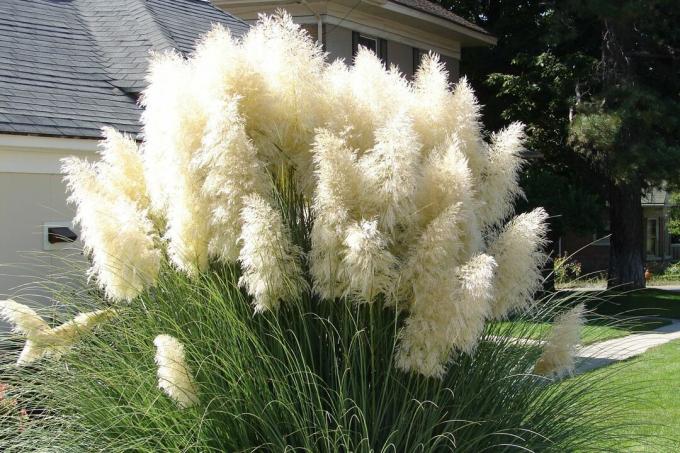
The pampas grass (Cortaderia) is one of the most popular ornamental grasses in our gardens. It can be found solitary, as an attractive solitary plant, or in clusters, as a decorative privacy screen. The pampas grass grows in clumps, so it always sprouts from the mother plant and belongs to the sweet grass family (Poaceae).
contents
- Pampas grass: properties and appearance
- Pampas grass: Different shapes and varieties
- Pampas grass as a privacy screen
-
Planting pampas grass: location and procedure
- When to plant pampas grass
- How do I plant pampas grass?
- Plant pampas grass: step-by-step instructions
- Pampas grass in the pot and on the balcony
-
Propagating and dividing pampas grass
- Sow pampas grass and grow in the pot
- Share pampas grass
-
Caring for pampas grass: fertilize and water properly
- Fertilize pampas grass: Organic or mineral fertilizer
- Water pampas grass
- Cutting back pampas grass: pro tips
- Overwinter pampas grass successfully
Pampas grass: properties and appearance
Especially the American pampas grass (Cortaderia selloana) is very common in our country. It originally comes from a subtropical area, the grass steppe "Pampas" on the southeast coast of South America. In summer, the non-poisonous plant forms large, mostly silvery-white panicles of flowers, which present an impressive spectacle with their stem lengths of up to 2.50 m and more. However, depending on the variety, the ornamental grass also has fronds of flowers in other pastel shades.
However, the evergreen leaves grow to a maximum height of 1 m. Here, too, a wide variety of leaf patterns can be found. Due to its graceful growth and the special height of its inflorescence, the pampas grass is an impressive exotic in ornamental gardens.
Pampas grass: Different shapes and varieties
Worldwide we find a huge, previously undocumented variety of different forms and varieties of pampas grass. The beautiful sweet grass is distinguished primarily by the height of its growth and the color of its flower panicles.
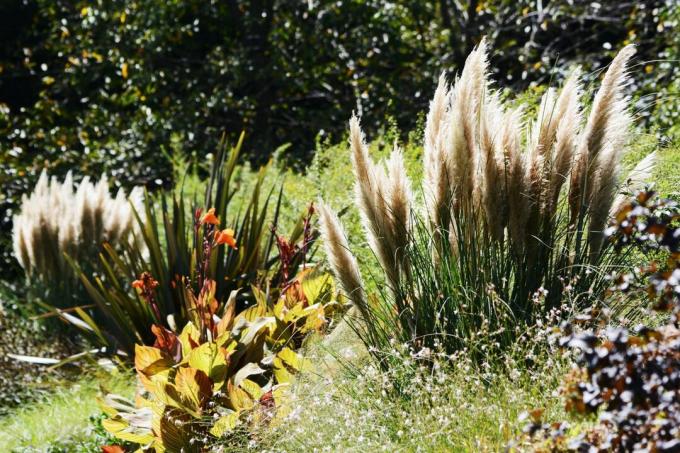
Pampas Grass Varieties: The 5 Most Popular Varieties
'compacta' is a hardy small ornamental grass. Its flower stalks reach a height of up to 120 cm. Even in the width of the clump, the plant remains at a diameter of half a meter. The panicle, which blooms in September to October, is creamy white in colour.
The leaves of the 'Compacta' pampas grass are green and deciduous. As long as the ornamental shrub is not exposed to waterlogging, it can be planted well in stone beds or stone gardens. Due to its not too high growth, it is a good eye-catcher without blocking the whole view at the same time.
‚Evita' also belongs to the smaller but very elegant grasses. A large number of light yellow to yellow-gold fronds develop from August to October. The leaves are grey-green and hardy. The whole plant grows very sprawling. Due to its compact growth and long-lasting flowers, 'Evita' is also well suited for garden tubs. It is important that the plant has enough space to develop, so do not choose a bucket that is too small and please use potting soil that is well permeable to water. The pampas grass grows to a height of around 1.20 m and prefers a semi-shady spot. When planting in tubs, a change of location to a frost-protected room would be best for a harmless hibernation. This type of ornamental grass often flowers in the first year of planting.
'rosea' is characterized by its rare pink panicles. It is a very special beauty for the garden and grows up to 2 m high. The flowers of the 'Rosea' appear in September and October and are pink to gray in colour.
The foliage consists of narrow, green-grey leaves that are about 1 m long.
'Rendatleri' is also a pink-flowering ornamental grass plant that can reach a height of up to 250 cm. Its leaves are deciduous and almost 150 cm long. We can see the beautiful flowers from September to November. They are a real eye-catcher for every garden.
'Sunningdale Silver' reaches an impressive size of 250 cm. A slender grass beauty with its long silvery-white fronds, 'Sunningdale Silver' can be described as a hardy classic among the pampas grasses. It is most impressive as a solitary plant. The leaves are very narrow, grey-green and, like all pampas leaves, sharp-edged. They can reach a length of 120 cm. The eyrie of the plant can spread up to a diameter of 130 cm.
Pampas grass as a privacy screen
If you want to plant pampas grass as a privacy screen, you should use tall grasses. 'Sunningdale Silver', 'Rendatleri' and also the 'White Feather' reach a height of up to 250 cm. Pampas grass is very decorative and fast-growing. Especially when the grassy privacy screen is to protect against the sun in summer, such a location suits the preferences of the plants very much - they particularly like sunny places.

Before winter sets in, the fronds should be tied together to better protect the grass from the winter wet. However, this limits the visibility. The plants are cut back once a year in the spring months. For a short time, the privacy protection is almost completely lost. But after just a few weeks, the new shoots have grown up again and you can look forward to the budding of the flowers.
Planting pampas grass: location and procedure
The location for the pampas grass should be carefully selected - not because it is so demanding, but rather because of its enormous growth potential.
-
Pampas grass needs enough space
If you would like to bring the pampas grass into your garden as an ornamental plant, then please note from the outset that even the small varieties grow to a good 120 cm and can reach a diameter of one meter and more be able. So you need enough space. -
Pampas grass loves sunny and warm locations
If you have chosen a sunny and warm location, then the habitat for the roots of the pampas grass must still be made loose and permeable to water. Soil that is too loamy would store too much moisture in winter and the roots would rot. The ornamental grass likes it when you mix in sand or small gravel. A good dose of humus or a primarily organic long-term fertilizer like ours should also be given Plantura organic universal fertilizer be mixed in.

When to plant pampas grass
Pampas grass should be planted in spring or early summer. In this way, the new garden dweller can develop well over the course of the year and is well rooted in the location for the next hibernation and ready for cold temperatures.
How do I plant pampas grass?
The planting hole is dug about 40 to 45 cm deep. It is advisable to water the eyrie of the plant well before planting. The best way to do this is to submerge it in a large bucket or tub of water until it's completely soaked. Then place in the planting hole, fill with soil and press down firmly. Pay attention to the distances between the individual plants (100 to 130 cm). No foothills form with pampas grass, so a rhizome barrier is not necessary.
Plant pampas grass: step-by-step instructions
- After the ground is frost-free (the ice saints should be over), the pampas grass can be planted outdoors.
- Dig a planting hole of about 40 - 45 cm - also make sure it is wide enough.
- If the soil is not permeable enough, mix some sand or fine gravel into the excavation.
- Add some humus-rich plant substrate and use the watered plant.
- Depending on the growth height of the grass, a distance of 1 - 1.3 m should be maintained between the plants.
- Water particularly well for the next 14 days, but avoid waterlogging.

Attention: Be sure to wear gloves when planting pampas grass. The foliage is extremely sharp-edged and can inflict nasty cuts.
A detailed expert guide to Planting pampas grass see here.
Pampas grass in the pot and on the balcony
The pampas grass is not only an attractive addition to the garden in the bed. It also looks very decorative in tubs and pots, on terraces and balconies. In a pot or tub, the pampas grass usually does not reach the same height as in the bed, but remains a little smaller than in the field. Nevertheless, the planter must be generous in depth and width, it should have a capacity of at least 40 to 45 liters. Use a suitable soil for planting, such as our peat-free Plantura organic universal soil, which contains all the necessary nutrients for healthy growth.
When planting pampas grass in a pot, it is advantageous if the bottom has drainage holes to prevent waterlogging. You can also put shards of pottery or larger pebbles as the bottom infill, this will give you a simple drainage that will have the same effect. If there are drainage holes, the bucket should be placed on a saucer. In order to be able to move the heavy vessels in the winter without much effort, and so they do To protect them from extreme cold, it is advisable to cover them on small roller boards when planting them place.
More useful tips for that Planting pampas grass in a pot you'll find here.
Propagating and dividing pampas grass
You have two options for propagating your pampas grass: Firstly, you can sow the grass yourself. On the other hand, by dividing the pampas grass, you can quickly and easily turn one plant into several. No matter which method of propagation you choose - we take a closer look at both ways.
Sow pampas grass and grow in the pot
If you want to sow pampas grass, you can either use seeds you have collected yourself from existing plants in your garden, or you can buy seeds from a specialist dealer. The latter is the better option, since pampas grass is dioecious (there are male and female plants). Since you cannot tell from the seed what kind of plant it is, you should prefer the goods from the dealer, that's where you get them only female seeds, as the female grasses grow much more luxuriantly and form more and larger fronds than the males Plant.
You can sow the seeds in the pot as early as March and leave them there until the ice saints are over in May. To do this, place the seeds some distance apart on pots filled with good potting soil. Then the seeds are briefly pressed and watered. In the further course, make sure that the swelling and germinating seeds never dry out. Drought during the germination process could cause failure. Either cover the seed pots with a sheet of glass or spray the surface regularly with a fine spray bottle.

Notice: Don't put extra soil over the seeds after tamping. Pampas grass needs light to germinate, so it needs light to germinate.
You can then plant the germinated seedlings outdoors in May when no more frost is to be expected. If you want to be on the safe side, repot the seedlings and keep them in the container until the following year. Then they are guaranteed to be robust enough to withstand the outdoors.
Share pampas grass
Vegetative breeding by dividing a mother plant is easier and more effective. In doing so, you completely or partially uncover the eyrie of the desired grass from your garden and cut off a piece of it with a spade. Then the partial plant is placed in a sufficiently large, prepared hole, into which you should ideally put some humus-rich compost for a good start fertilization. It is best to divide the pampas grass in the spring after it has been cut back. Then it has enough time to root again until the next winter.
Caring for pampas grass: fertilize and water properly
Pampas grass is a fast-growing ornamental plant. During the growth phase, it needs plenty of nutrients, which is why regular fertilization makes sense.
Fertilize pampas grass: Organic or mineral fertilizer
In the phase of greatest growth (spring to late summer), regular application of fertilizer is very important.
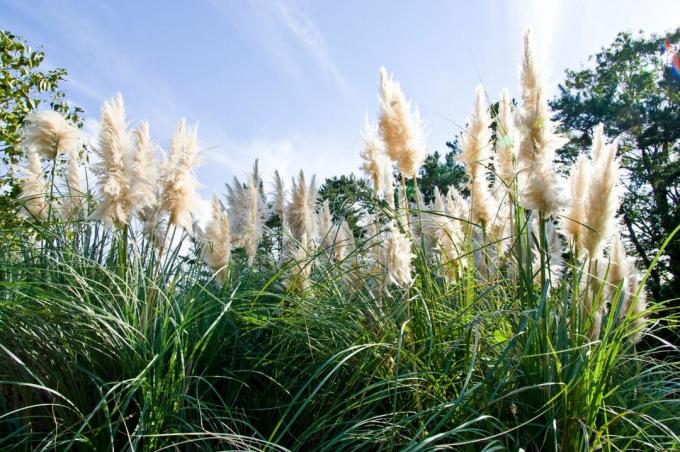
It is therefore advantageous to add a starter fertilizer to the planting hole when planting or transplanting. For the extra portion of nutrients in particularly vigorous years and the supply of all trace elements, it is advisable to apply a complete fertilizer. Primarily organic fertilizers are the most sustainable choice and also have many advantages. On the one hand, they promote soil life and enrich the soil with new organic matter. On the other hand, the structural properties of the soil are also positively influenced. Last but not least, organic fertilizers are primarily resource-saving because they are largely made from organic waste and other biological recycling material. Also with ours Plantura organic universal fertilizer is such a sustainable and primarily organic fertilizer.
Water pampas grass
As a rule, the root system of a pampas grass is sufficiently developed to absorb enough water from the soil. Additional watering only makes sense in particularly dry phases during the main growth period. However, if the pampas grass is in a pot, it must of course be watered much more regularly. But waterlogging should also be avoided here. If a pampas grass has been transplanted or divided and then planted again, make sure you water it regularly until the pampas grass has sufficiently acclimatized to the new location. But the same applies here: Avoid waterlogging at all costs.
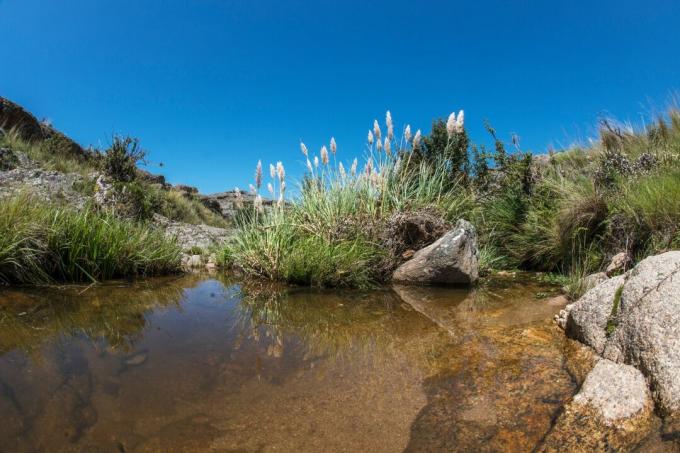
Cutting back pampas grass: pro tips
Pampas grass is one of the most beautiful ornamental grasses. It should be cut back once a year so that the special lushness of its inflorescence is promoted or maintained.
Do you have to cut pampas grass?
Pruning is very important because this ornamental grass is a clump-forming plant. It drives out again and again from the mother plant. Since the stems and leaves dry up in late autumn, enough space and light must be created for the new shoots in spring. This is the only way to guarantee dense and beautiful new growth.
When and how to cut pampas grass?
It is important to ensure that the pruning takes place in the spring, from March to May, depending on the weather. It is not good to do this tending work in the fall because the stalks of the pampas grass are hollow. If you cut back in autumn, too much water would accumulate in it and the perennial would very likely partially or even completely rot due to the moisture.
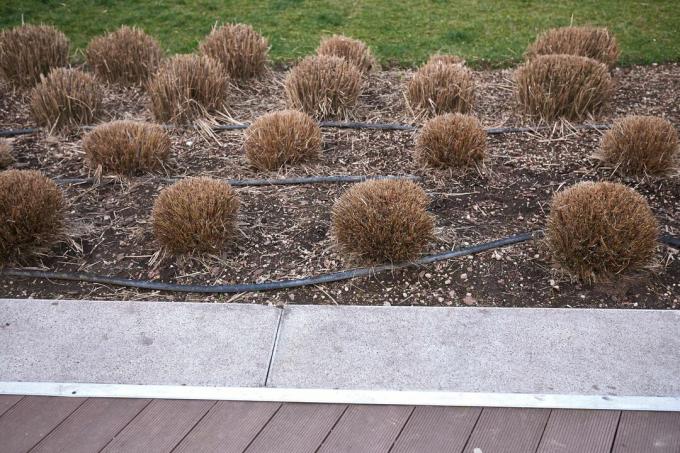
If your ornamental grass is in a bucket and is brought into a frost-free room over the winter, you should only prune it in the spring. The ideal time is when the first new shoot tips can be seen. Then cut your pampas grass down to about 15 to 20 cm with sharp pruning shears.
Caution: Remember to always wear gloves when working with pampas grass so you don't cut yourself on the leaves.
Detailed instructions and other tips for Pampas Grass Cutting can be found in our special article on this.
Overwinter pampas grass successfully
Pampas grass is not completely hardy in our latitudes and needs winter protection. In late autumn, when the stems have dried up, tie them together at the top. You should spread a layer of straw or dry leaves on the lower part of the plant and then layer brushwood on top. If possible, wrap the entire height of the plant in fleece or a coconut mat. Protected in this way, the pampas grass can also withstand colder temperatures of down to -10 to -15 °C.

If your pampas grass is in a planter, you should find winter quarters for the ornamental grass in good time and water it moderately from time to time. If it is not possible to move the plant to a sheltered area, wrap the pot in bubble wrap and place it on a piece of Styrofoam or some wooden slats. The same applies here: it is best to wrap the entire height of the grass in fleece. This is how winter can come.
Ornamental grasses are becoming increasingly popular. We have the best for you Ornamental grasses for the garden compiled.
